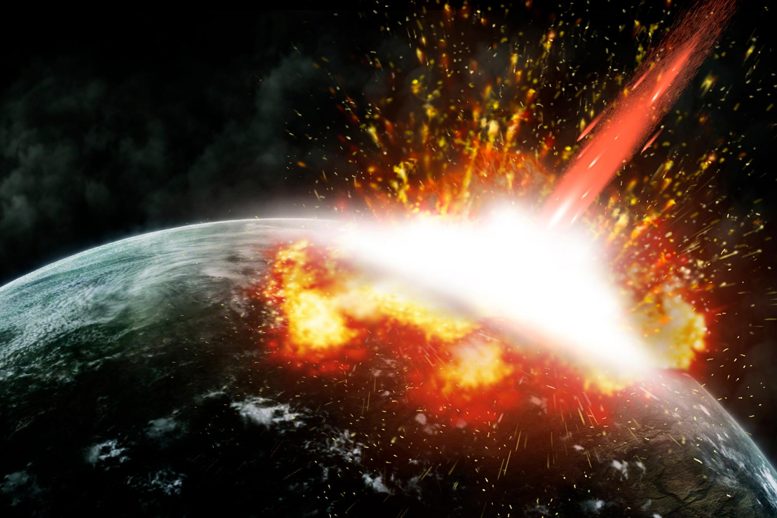
The new research indicates that the impactor would have to be about 20 to 25 kilometers (12.4 to 15.5 miles) in size and move at a velocity of 15 to 20 kilometers (9.3 to 12.4 miles) per second.
Researchers at the University of Rochester have created a more accurate simulation of the impact that created the Vredefort crater two billion years ago.
An impactor hurtled toward Earth around two billion years ago, crashing into the planet not far from where Johannesburg, South Africa is now. The impactor, most likely an asteroid, created what is now the largest crater on Earth. Based on earlier research, it is largely acknowledged by scientists that the Vredefort crater was created by an object with a diameter of around 15 kilometers (about 9.3 miles) and a velocity of 15 kilometers per second.
However, a recent study from the University of Rochester suggests that the impactor may have been significantly larger, which would have had catastrophic effects on the whole planet. This study, which was recently published in the Journal of Geophysical Research, improves our understanding of the massive impact and paves the way for more realistic simulations of impact events that have occurred on Earth and other planets both in the past and in the future.
“Understanding the largest impact structure that we have on Earth is critical,” says Natalie Allen ’20, now a Ph.D. student at John Hopkins University. Allen is the first author of the paper, based on research she conducted as an undergraduate at Rochester with Miki Nakajima, an assistant professor of Earth and environmental sciences. “Having access to the information provided by a structure like the Vredefort crater is a great opportunity to test our model and our understanding of the geologic evidence so we can better understand impacts on Earth and beyond.”
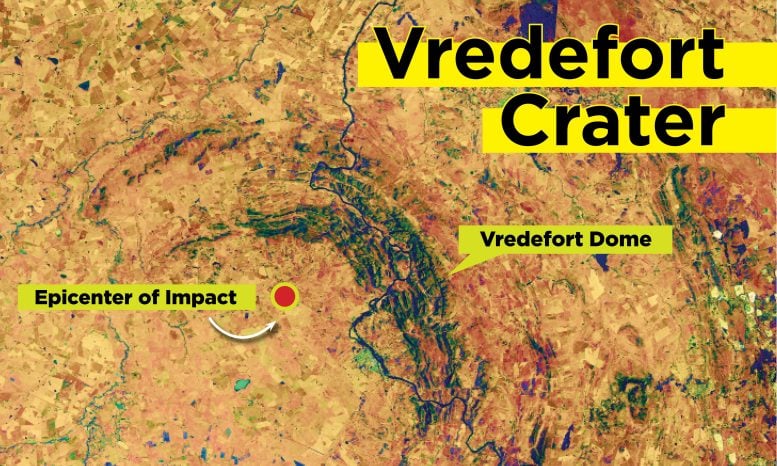
An impactor–most likely an asteroid–hurtled toward Earth about two billion years ago, crashing into the planet near present-day Johannesburg, South Africa. The impactor formed the Vredefort crater, what is today the biggest crater on our planet. Using updated simulation data, University of Rochester researchers discovered the impactor that formed the Vredefort crater was much larger than previously believed. Credit: NASA Earth Observatory image by Lauren Dauphin / University of Rochester illustration by Julia Joshpe
Updated simulations suggest ‘devastating’ consequences
The Vredefort crater has eroded over a two billion-year period. Because of this, it is difficult for scientists to determine the exact size of the crater at the time of the original impact and, therefore, the size and velocity of the impactor that created the crater.
A crater of 172 kilometers (107 miles) in diameter would be created by an object that is 15 kilometers (9.3 miles) in size and moving at a velocity of 15 kilometers (9.3 miles) per second. However, this is substantially smaller than current Vredefort crater estimates. Based on new geological evidence and measurements, scientists estimate that the structure’s original diameter would have been between 250 and 280 kilometers (between 155 and 174 miles) at the time of the impact.
Allen, Nakajima, and their colleagues conducted simulations to match the updated size of the crater. Their results showed that an impactor would have to be much larger—about 20 to 25 kilometers (12.5 to 15.5 miles)—and traveling at a velocity of 15 to 20 kilometers (9.3 to 12.4 miles) per second to explain a crater 250 kilometers in size.
This means the impactor that formed the Vredefort crater would have been larger than the asteroid that killed off the dinosaurs 66 million years ago, forming the Chicxulub crater. That impact had damaging effects globally, including greenhouse heating, widespread forest fires, acid rain, and destruction of the ozone layer, in addition to causing the Cretaceous-Paleogene extinction event that killed the dinosaurs.
If the Vredefort crater was even larger and the impact more energetic than that which formed the Chicxulub crater, the Vredefort impact may have caused even more catastrophic global consequences.
“Unlike the Chicxulub impact, the Vredefort impact did not leave a record of mass extinction or forest fires given that there were only single-cell lifeforms and no trees existed two billion years ago,” Nakajima says. “However, the impact would have affected the global climate potentially more extensively than the Chicxulub impact did.”
Dust and aerosols from the Vredefort impact would have spread across the planet and blocked sunlight, cooling the Earth’s surface, she says. “This could have had a devastating effect on photosynthetic organisms. After the dust and aerosols settled—which could have taken anywhere from hours to a decade—greenhouse gases such as carbon dioxide that were emitted from the impact would have raised the global temperature potentially by several degrees for a long period of time.”
A multi-faceted model of Vredefort crater
The simulations also allowed the researchers to study the material ejected by the impact and the distance the material traveled from the crater. They can use this information to determine the geographic locations of land masses billions of years ago. For instance, previous research determined material from the impactor was ejected to present-day Karelia, Russia. Using their model, Allen, Nakajima, and their colleagues found that, two billion years ago, the distance of the land mass containing Karelia would have been only 2,000 to 2,500 kilometers from the crater in South Africa—much closer than the two areas are today.
“It is incredibly difficult to constrain the location of landmasses long ago,” Allen says. “The current best simulations have mapped back about a billion years, and uncertainties grow larger the further back you go. Clarifying evidence such as this ejecta layer mapping may allow researchers to test their models and help complete the view into the past.”
Undergraduate research leads to the publication
The idea for this paper arose as part of a final for the course Planetary Interiors (now named Physics of Planetary Interiors), taught by Nakajima, which Allen took as a junior.
Allen says the experience of having undergraduate work result in a peer-reviewed journal article was very rewarding and helped her when applying for graduate school.
“When Professor Nakajima approached me and asked if I wanted to work together to turn it into a publishable work, it was really gratifying and validating,” Allen says. “I had formulated my own research idea, and it was seen as compelling enough to another scientist that they thought it was worth publishing!”
She adds, “This project was way outside of my usual research comfort zone, but I thought it would be a great learning experience and would force me to apply my skills in a new way. It gave me a lot of confidence in my research abilities as I prepared to go to graduate school.”
Reference: “A Revision of the Formation Conditions of the Vredefort Crater” by Natalie H. Allen, Miki Nakajima, Kai Wünnemann, Søren Helhoski and Dustin Trail, 8 August 2022, Journal of Geophysical Research Planets.
DOI: 10.1029/2022JE007186
The study was funded by the National Science Foundation.


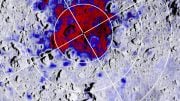
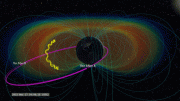
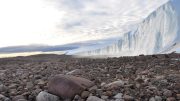
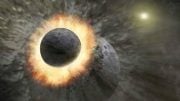
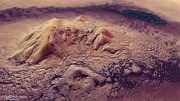
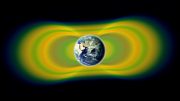

And so the artist’s impression is an impactor ~1500 miles in diameter.